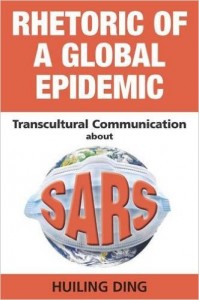Scholarly monograph
Rhetoric of Global Epidemic: Transcultural Communication about SARS. Southern Illinois University Press. 2014.
Book review from
- Inside Higher Ed by Scott McLemee
- Technical Communication Quarterly by Michael Madson
Edited collection
Ding, Huiling, and Savage, Gerald. (2013). Guest editors. Technical Communication Quarterly Special Issue: New Developments in Inter/transcultural Professional Communication. 22.
Published
- Ding, H. (2020). Smart Crowdsourcing in COVID-19: Assisting Wuhan with Mobility in Lockdown. QED: A Journal in GLBTQ Worldmaking. Forthcoming.
- Ding, H., Fang, X., Menzies, T., Shen, X., Chi, M. (2020). Building Ethical AI for Workforce Empowerment, Upskilling, and Reemployment in Manufacturing. Conference Proceedings, AI and Manufacturing, AAAI Spring Symposium.
- Ding, H. (2020). Crowdsourcing, Social Media, and Intercultural Communication about Zika: Use Contextualized Research to Bridge the Digital Divide in Global Health Intervention. Journal of Technical Writing and Communication. 50, 141 – 166.
- Ding, H. (2019). Development of Technical Communication in China: Program building and field convergence. Technical Communication Quarterly. 28, 223-237
- Ding, H. (2019). The Materialist Rhetoric about SARS Sequelae in China: Networked Risk Communication, Social Justice, and Immaterial Labor. Ed., In Walsh, L., & Gruber, D. (Ed). Routledge Handbook of Language & Science.
- Ding, H., & Kong, Y. (2019). Constructing artificial intelligence in the U.S. and China: A cross-cultural, corpus-assisted study. China Media Research, 15.1, 93-105.
- Ding, H., Ranade, N., Cata, A. (2019). Boundary of content ecology: Chatbots, user experience, heuristics, and pedagogy. SIGDOC’19 Proceedings.
- Ding, H. (2018). Development of technical communication in China: Program building and field convergence. Technical Communication Quarterly. 28, 1-15.
- Ding, H. (2018). Cross-cultural whistle-blowing in emerging outbreaks: Revealing health risks through tactic communication and rhetorical hijacking. Communication Design Quarterly. 6.1, 35-44.
- Ding, H., & Li, X. (2018). Technical translation in China. Routledge Handbook of Chinese Translation. In Shei, C., & Gao, Z. (Ed). New York, NY: Routledge. 537-550. (60% contribution).
- Ding, H. & Zhang, J. (2017). Imagining Health Risks: Fear, Fate, Death, and Family in Chinese and American Online Discussion Forums about HIV/AIDS. In Hartnett, S., Keränen, L., & Conley, D. (Ed). Imagining China: Rhetorics of Nationalism in an Age of Globalization. Lansing, MI: Michigan State University Press. 235-270. (60% contribution)
- Ding. H. (2017). Cross-culturally narrating risks, imagination, and realities of HIV/AIDS: Emerging genre of online “risky aids narratives” and potential intermediation of this occluded genre. Ed. Miller, Carolyn and Kelly, Ashley. Emerging Genres in New Media Environments. Palgrave MacMillan. 153-170.
- Ding, H. (2017). Content Strategy: The Next Growing Market of Technical Communication. TCShanghai. (Written in Chinese) First place, International Essay Contest in Technical Communication
- Zhang, J., & Ding, H. (2014). Constructing HIV/AIDS on the Internet: A comparative rhetorical analysis of online narratives in the United States and in China. International Journal of Communication. 8, 1415–1436.
- Ding, H. (2014). Transnational Quarantine Rhetorics: Public Mobilization in SARS and in H1N1 Flu. Journal of Medical Humanities. 35, 191–210.
- Ding, H. (2014). Book review of Barry Thatcher Intercultural Rhetoric and Professional Communication: Technological Advances and Organizational Behavior. IGI Global. 417pp. Technical Communication Quarterly.
- Ding, H., & Pitts, E. (2013). Singapore’s quarantine rhetoric and human rights in emergency health risks. Rhetoric, Professional Communication, and Globalization. 4.1, 55-77. Special issue on human rights. (70% contribution)
- Ding, H., and Ding, X. (2013). 360-degree rhetorical analysis of job hunting: A four-part, multimodal project. Business Communication Quarterly. 76(2) 239–248
- Ding, H. (2013). Transcultural risk communication and viral discourses: Grassroots movements to manage global risks of H1N1 flu Pandemic. Technical Communication Quarterly. 22, 126-149. 2014 Nell Ann Pickett Award for Best Article in TCQ
- Ding, Huiling, & Savage, Gerald. (2013). Guest editors’ introduction: New directions in intercultural professional communication. Technical Communication Quarterly. 22, 1-9. (70% contribution)
- Ding, H. (2013). My professional life as an ESL trainer/technical translator in Shanghai, China. In Yu, H. & Savage, J. (Ed). Negotiating Cultural Encounters: Narrating Intercultural Engineering and Technical Communication. Hoboken, NJ: Wiley/IEEE Press. 247-282
- Ding, Huiling. (2012). Grassroots emergency health risk communication and transmedia public participation: H1N1 flu, travelers from epicenters, and cyber vigilantism. Rhetoric, Professional Communication, and Globalization. 3, 15-35.
- Ding, Huiling, & Zhang, Jingwen. (2010). Social media and participatory risk communication during the H1N1 flu epidemic: A comparative study of the United States and China. China Media Research. 6, 80-90. (60% contribution)
- Ding, Huiling. (2010). Technical communication instruction in China: Localized programs and alternative models. Technical Communication Quarterly.19, 300–317.
- Ding, Huiling. (2010). A case study of the impact of digital documentation on professional change: The WPA electronic mailing list, knowledge network, and community outreach.” Ed. Lamberti, Adrienne, and Anne R. Richards. Complex Worlds: Digital Culture, Rhetoric, and Professional Communication. Amityville, NY: Baywood Publishing Company. 117-132.
- Ding, Huiling. (2009). Rhetorics of alternative media in an emerging epidemic: SARS, censorship, and participatory risk communication. Technical Communication Quarterly. 18, 327–350.
- Ding, Huiling. (2009). Alternative forms of technical communication in China: Localized programs and new developments. Conference of Professional, Technical, Scientific Communication Proceeding.
- Ding, Huiling. (2008). The use of cognitive and social apprenticeship to teach a disciplinary genre: Initiation of graduate students into NIH grant writing. Written Communication. 25, 3-52. 2008 Editor’s Pick New Scholar Award
- Ding, Huiling, & Ding, Xin. (2008). Project management and process-oriented approach to teamwork. Business Communication Quarterly. 71, 456-471. (80% contribution)
- Ding, H. (2007). Open source: Platform for virtual service learning and user-initiated research. International Professional Communication Conference Proceeding
- Ding, Huiling. (2007). Confucius’ virtue-centered rhetoric: A case study of the Analects with mixed research methods. Rhetoric Review. 26, 142–59.
- Ding, Huiling. (2007). Genre analysis of personal statements: Analysis of moves in application letters to medical schools. English for Specific Purposes. 26, 368–392.
- Ding, H. (2005). Book review of Innovative approaches to teaching technical communication. Journal of Business and Technical Communication 19, 222-225.
- Ding, H. (2004). The use of the electronic-portfolio in writing classrooms: A developmental approach. Louisiana English Journal. 100-106

